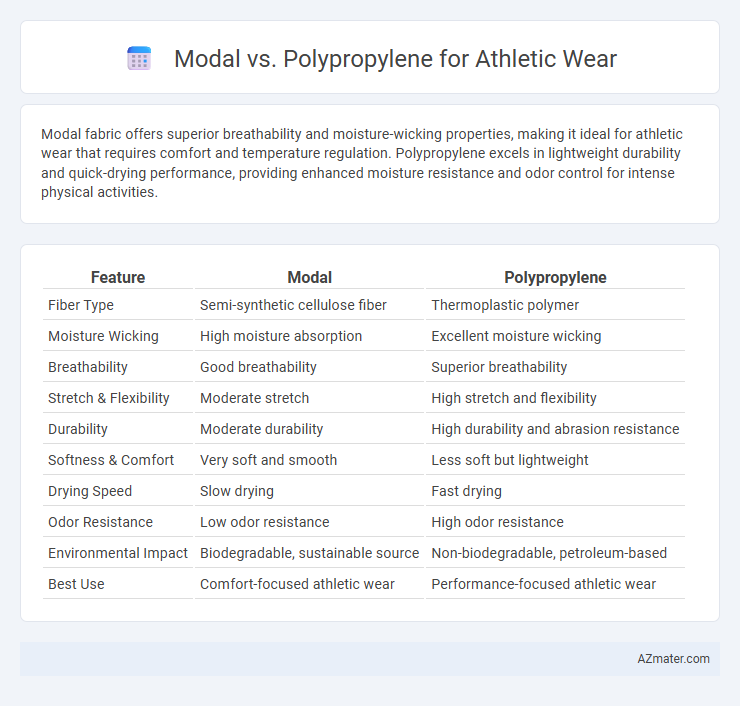Modal fabric offers superior breathability and moisture-wicking properties, making it ideal for athletic wear that requires comfort and temperature regulation. Polypropylene excels in lightweight durability and quick-drying performance, providing enhanced moisture resistance and odor control for intense physical activities.
Table of Comparison
| Feature | Modal | Polypropylene |
|---|---|---|
| Fiber Type | Semi-synthetic cellulose fiber | Thermoplastic polymer |
| Moisture Wicking | High moisture absorption | Excellent moisture wicking |
| Breathability | Good breathability | Superior breathability |
| Stretch & Flexibility | Moderate stretch | High stretch and flexibility |
| Durability | Moderate durability | High durability and abrasion resistance |
| Softness & Comfort | Very soft and smooth | Less soft but lightweight |
| Drying Speed | Slow drying | Fast drying |
| Odor Resistance | Low odor resistance | High odor resistance |
| Environmental Impact | Biodegradable, sustainable source | Non-biodegradable, petroleum-based |
| Best Use | Comfort-focused athletic wear | Performance-focused athletic wear |
Introduction to Modal and Polypropylene Fabrics
Modal fabric, derived from beech tree pulp, is a semi-synthetic cellulose fiber known for its exceptional softness, breathability, and moisture-wicking properties, making it ideal for athletic wear that demands comfort during intense physical activity. Polypropylene, a synthetic thermoplastic polymer, offers superior water resistance, lightweight durability, and excellent thermal regulation, which enhances performance in high-intensity workouts by effectively repelling sweat and maintaining insulation. Both fabrics serve distinct functional purposes in athletic apparel, with Modal excelling in softness and moisture absorption, while Polypropylene provides robust performance benefits under wet and strenuous conditions.
Key Properties of Modal in Athletic Wear
Modal fabric offers superior moisture-wicking capabilities, making it ideal for athletic wear by keeping the skin dry during intense workouts. Its exceptional softness and breathability enhance comfort, reducing irritation and promoting better airflow compared to polypropylene. Modal's biodegradability and durability provide eco-friendly longevity, distinguishing it from the synthetic nature and lower moisture management of polypropylene in activewear applications.
Key Properties of Polypropylene in Sports Apparel
Polypropylene in athletic wear offers exceptional moisture-wicking abilities, keeping athletes dry by quickly moving sweat away from the skin. Its lightweight and breathable nature enhances comfort without adding bulk, making it ideal for high-intensity sports activities. The fabric's durability and resistance to abrasion ensure long-lasting performance, while its quick-drying and odor-resistant properties contribute to maintaining freshness during prolonged workouts.
Moisture-Wicking Capabilities: Modal vs Polypropylene
Polypropylene outperforms Modal in moisture-wicking capabilities due to its hydrophobic nature, efficiently repelling water and quickly transporting sweat away from the skin. Modal, a semi-synthetic fabric derived from beech trees, absorbs moisture rather than repelling it, making it less effective for high-intensity athletic wear. Athletes seeking superior sweat management and quick-dry performance often prefer polypropylene for enhanced comfort and odor resistance during rigorous activities.
Breathability and Comfort Comparison
Modal fabric offers superior moisture-wicking properties and a silky texture, making it exceptionally breathable and comfortable for athletic wear. Polypropylene excels in moisture resistance and quick-drying capabilities but tends to be less soft and breathable compared to Modal. Athletes seeking maximum comfort and enhanced ventilation typically prefer Modal, while Polypropylene is favored for high-performance moisture management.
Durability and Maintenance for Active Lifestyles
Modal offers superior softness and breathability but lacks the durability of polypropylene, which is engineered for high-performance athletic wear due to its excellent abrasion resistance and moisture-wicking properties. Polypropylene withstands frequent washing and intense physical activity without degrading, making it ideal for active lifestyles requiring durable, low-maintenance clothing. Modal may require gentler care to maintain fabric integrity, while polypropylene's quick-dry, stain-resistant characteristics simplify maintenance and extend garment lifespan.
Eco-Friendliness and Sustainability Factors
Modal fabric, derived from beech tree pulp, is highly biodegradable and produced using less water compared to traditional cotton, making it a more sustainable choice for athletic wear. Polypropylene, a synthetic polymer made from fossil fuels, has a lower environmental footprint during production due to energy efficiency but poses significant challenges in biodegradability and microplastic pollution. Choosing modal supports reduced ecological impact through renewable sources and enhanced recyclability, while polypropylene excels in durability and moisture-wicking but contributes to long-term environmental concerns.
Odor Resistance in Modal and Polypropylene
Modal offers moderate odor resistance due to its breathable, moisture-wicking properties that help reduce sweat buildup and bacterial growth during workouts. Polypropylene provides superior odor resistance by repelling moisture entirely, preventing sweat absorption and limiting bacteria proliferation more effectively than most natural fibers. Athletes seeking long-lasting freshness often prefer polypropylene for its high-performance odor control in intense physical activities.
Best Athletic Applications for Each Material
Modal offers superior moisture-wicking and breathability, making it ideal for lightweight, high-intensity athletic wear like running shirts and yoga apparel. Polypropylene excels in water resistance and quick-drying properties, perfect for outdoor sportswear, base layers, and moisture management in harsh conditions. Athletes benefit from Modal's softness for comfort and Polypropylene's durability and thermal insulation for extended performance.
Choosing the Right Fabric for Athletic Performance
Modal offers superior moisture-wicking and breathability, making it ideal for high-intensity workouts where sweat management is critical. Polypropylene excels in water resistance and quick drying, providing lasting comfort and odor control during prolonged or outdoor activities. Selecting the right fabric depends on balancing breathability and durability to optimize athletic performance and comfort.

Infographic: Modal vs Polypropylene for Athletic Wear
 azmater.com
azmater.com